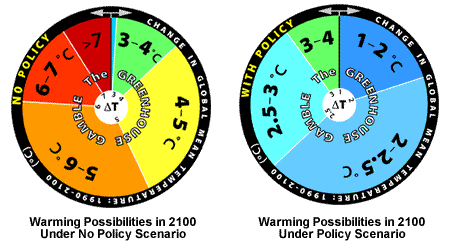The Massachusetts Institute of Technology Joint Program on the Science and Policy of Climate Change has joined the climate realists. The realists are the growing group of scientists who understand that the business as usual emissions path leads to unmitigated catastrophe (see, for instance, here and below).
The Program issued a remarkable, though little-remarked-on, report in January, “Probabilistic Forecast for 21st Century Climate Based on Uncertainties in Emissions (without Policy) and Climate Parameters” (see here), by over a dozen leading experts. They reanalyzed their model’s 2003 projections model using the latest data, and concluded:
The MIT Integrated Global System Model is used to make probabilistic projections of climate change from 1861 to 2100. Since the model’s first projections were published in 2003 substantial improvements have been made to the model and improved estimates of the probability distributions of uncertain input parameters have become available. The new projections are considerably warmer than the 2003 projections, e.g., the median surface warming in 2091 to 2100 is 5.1°C compared to 2.4°C in the earlier study.
Their median projection for the atmospheric concentration of carbon dioxide in 2095 is a jaw-dropping 866 ppm.

Projected decadal mean concentrations of CO2. Red solid lines are median, 5% and 95% percentiles for present study: dashed blue line the same from their 2003 projection.
Why the change? The Program’s website explains:
There is no single revision that is responsible for this change. In our more recent global model simulatations, the ocean heat-uptake is slower than previously estimated, the ocean uptake of carbon is weaker, feedbacks from the land system as temperature rises are stronger, cumulative emissions of greenhouse gases over the century are higher, and offsetting cooling from aerosol emissions is lower. No one of these effects is very strong on its own, and even adding each separately together would not fully explain the higher temperatures. Rather than interacting additively, these different affects appear to interact multiplicatively, with feedbacks among the contributing factors, leading to the surprisingly large increase in the chance of much higher temperatures.
The carbon sinks are saturating, and the amplifying feedbacks are worse than previously thought — that, of course, is a central understanding of all climate realists (see here for links to the various feedbacks that have been ignored by most climate models).
Andrew Freedman at washingtonpost.com has one of the very few stories on this important study and reprints this useful figure from MIT:

He explains:
Results of the studies are depicted online in MIT’s “Greenhouse Gamble” exercise that conveys the “range of probability of potential global warming” via roulette wheel graphics (shown above). The modeling output showed that under both a “no policy” scenario and one in which nations took action beginning in the next few years to reduce greenhouse gas emissions, the odds have shifted in favor of larger temperature increases.
For the no policy scenario, the researchers concluded that there is now a nine percent chance (about one in 11 odds) that the global average surface temperature would increase by more than 7°C (12.6°F) by the end of this century, compared with only a less than one percent chance (one in 100 odds) that warming would be limited to below 3°C (5.4°F).
To repeat, on our current emissions path, we have a 9 percent chance of an incomprehensibly catastrophic warming of 7°C by century’s end, but less than a 1 percent chance of under 3°C warming.
“The take home message from the new greenhouse gamble wheels is that if we do little or nothing about lowering greenhouse gas emissions that the dangers are much greater than we thought three or four years ago,” said Ronald G. Prinn, professor of atmospheric chemistry at MIT. “It is making the impetus for serious policy much more urgent than we previously thought.”
The time to act is now.
This post was created for ClimateProgress.org, a project of the Center for American Progress Action Fund.

